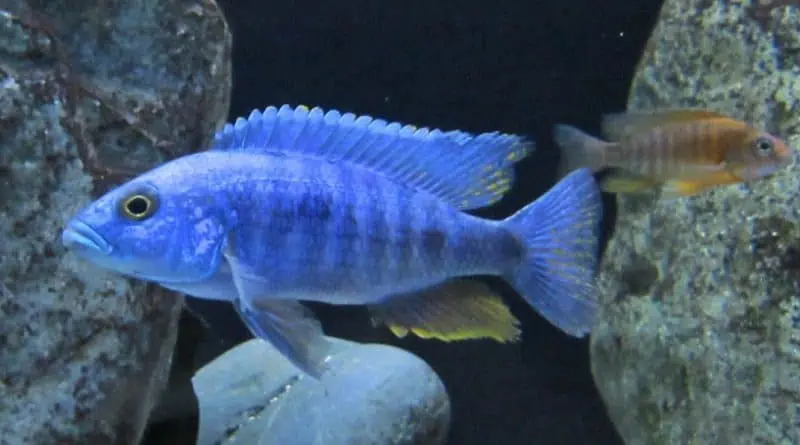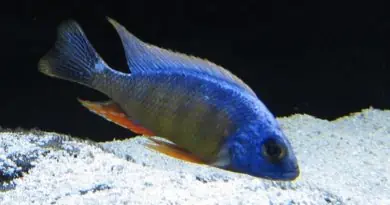What Causes Malawi Bloat
Malawi bloat is a blockage in the digestive tract of the fish causing the abdomen of the fish to swell excessively. Not only Malawi cichlids are susceptible to bloat and in severe cases, the whole fish’s body and eyes can swell and the fish will be breathing heavily.
The cause of Malawi bloat is a parasite called Hexamita (Hex) and the outbreak is usually brought about by one or a combination of the following; inappropriate or poor-quality diet, overfeeding, stress, or poor water quality.
Unfortunately, treatment is rarely effective unless the disease is caught and treated appropriately at the early stage. It’s one of those diseases that you want to prevent in the first place.
Prevention of Malawi Bloat:
To start, let’s have a look at some of the best ways to prevent your fish from getting Malawi bloat in the first place.
- Feed good quality African cichlid pellets.
- Avoid feeding bloodworms.
- Avoid overfeeding.
- Feed de-shelled frozen peas on occasion.
- Minimize stress.
- Maintain good water quality.
In my experience, the first three items in the above list are of vital importance in reducing the chances of your fish getting Malawi bloat. Make sure you’re feeding a good quality African cichlid pellet designed for the type of fish you are keeping. For example, mbuna require a heavily plant-based pellet. Whereas haps and peacocks should be fed a pellet that contains a higher level of protein.
Bloodworms are notorious for causing bloat in Malawi cichlids and should be avoided. The skin of the bloodworm is difficult for the fish to digest and can cause blockage in the gut. If you are looking to add variety to your fish’s diet, some great alternatives to bloodworms are frozen brine shrimp and mysis shrimp.
Most importantly, avoid overfeeding your fish. Overfeeding can easily cause blockage of the digestive tract. Smaller more frequent feeding is a better approach. You can refer to the article on feeding African cichlids for more comprehensive information.
De-shelled frozen peas work similar to a laxative and can be fed on occasion to help flush out the fish’s intestines. This can be done either weekly or monthly. When feeding peas, I time it for the day before water change as it can be quite messy.
Minimize stress as much as possible in your tank. This will help to ensure that your fish have a strong and well-functioning immune system to fight off diseases.
Maintain a high level of water quality. This applies to all aspects of fish health and the wellbeing of your tank in general.
Treatment of Malawi Bloat:
As mentioned earlier in the article. Treatment of Malawi bloat is rarely effective unless the disease is caught at the early stage and treated appropriately. Often treatment can seem to have worked only to have a reoccurrence soon after.
The first thing I do is move the bloated fish out of the main tank and into a quarantine tank, where it will be easier to treat. I normally use tank water to fill the quarantine tank, to avoid any shock to the fish when it is moved. You can do a water change on the quarantine tank the next day if needed to improve the water quality.
Once the fish is moved to quarantine, treatment will be done in three ways. This is done all at the same time. I don’t try feeding the fish for the first few days of treatment, as it could make the bloating issue worse.
- Reduce the swelling
- Clear the blockage
- Treatment with medication
Reduce the swelling:
To reduce the swelling of the fish I add two tablespoons of aquarium salt per 5 gallons of water to the quarantine tank. Some of the excess body fluid will be expelled out of the fish into the salty water due to the fish’s osmotic regulation process.
Clear the blockage:
In addition to the aquarium salt, I also add epsom salt (magnesium sulphate) at the same dosage, two tablespoons per 5 gallons of water to the quarantine tank. The epsom salt works as a laxative to help clear the blockage.
Treatment with medication:
When it comes to medication, Metronidazole is your best shot for treating bloat successfully as it is effective at eradicating the Hexamita parasite. However, depending on the condition of the fish it may be too late for the medication to have a chance of working.
Unlike the treatment for sunken belly, medicated food is not my preferred choice for getting the medicine into the fish. In this case I will treat the water instead.
Metronidazole Treatment
I treat with Seachem Metroplex on alternate days, with a 50% water change done before each dosing.
The dosage for Seachem Metroplex is 2 scoops per 10 gallons of water.
Note: The aquarium salt and epsom salt is added based on the volume of new water.
Day 1: Add Metro (2 scoops per 10 gallons of water).
Day 3: 50% water change. Add metro, aquarium salt and epsom salt.
Day 5: 50% water change. Add metro, aquarium salt and epsom salt.
Day 7: 50% water change
End of treatment
After this initial round of treatment, I will evaluate the fish to determine if sufficient progress has been made. If so, I will continue treatment without medication. If the fish is still in poor condition, I will try another week of medication, starting from day 1.
While the fish is being treated the only food I will feed it is a small amount of thawed out frozen brine shrimp. This is quite easy for the fish to digest and may help with clearing the blockage.
Conclusion:
Malawi bloat is probably the disease most African cichlid keepers fear the most as it is difficult to treat and fish usually die within days of becoming bloated. Due to the speed at which the fish deteriorates, medication may not have enough time to be effective.
Providing a proper diet and not overfeeding your fish will go a long way towards avoiding Malawi bloat.
Hopefully, you never encounter a case of this dreaded disease.
Thanks for reading. If you found this article helpful, don’t forget to share 🙂

